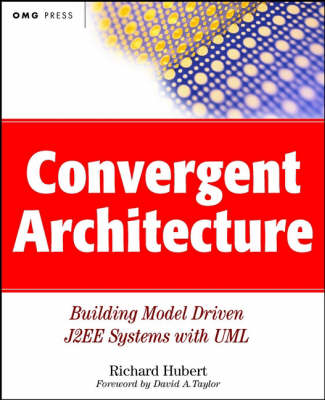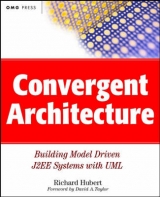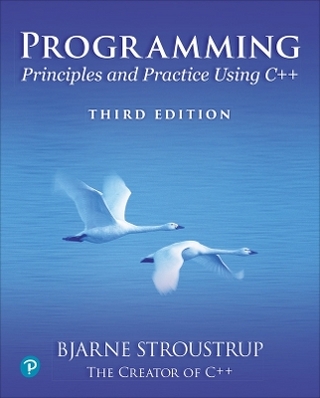Convergent Architecture
John Wiley & Sons Inc (Verlag)
978-0-471-10560-2 (ISBN)
- Titel ist leider vergriffen;
keine Neuauflage - Artikel merken
The only complete technical guide to building integrated business systems using the convergent architecture approach In his groundbreaking Business Engineering with Object Technology (0-471-04521-7), David Taylor introduced the concept of convergent architecture (CA), a framework for building the business design directly into the software systems that support it. Now, in this important follow-up to that 1995 classic, expert Richard Hubert provides systems developers and architects with their first complete blueprint for building integrated CA business systems using the hottest technologies, including Enterprise JavaBeans, XML, UML, Rational Rose, and others. Following a detailed introduction to the elements of CA, he walks readers through the entire CA design and implementation process, using examples in Java and EJB to illustrate key points. Companion Website provides hands-on tutorials, links to related tool sites, and updates to the CA methodology.
RICHARD HUBERT is an accomplished software architect who has won numerous international awards for large-scale software systems and architectural tools. As founding director of Interactive Objects Software GmbH (iO), he leads a large team of professional architects who apply Convergent Architecture across diverse industry segments. In 2000, iO introduced its Architectural IDE for MDA, ArcStyler. The author is also an active contributor to the OMG's MDA standardization effort.
Acknowledgments; Foreword; Introduction; Chapter 1. IT-Architectural Style; Discovering the Source of High Returns; A Long History of Success; A Higher Level of Communication; More than a Macro Pattern; The Next Level of Design; An Everybody-Wins Approach to Quality; Evolution without Revolution; Adding Innovation while Hedging Risks; The Importance of Style in IT Architecture; Designing an IT-Architectural Style; The Four Features of an IT-Architectural Style; Aspects Affecting Any IT-Architectural Style; Describing the Style Using Standards; Summary; Chapter 2. The Convergent Architecture Roadmap; The Anatomy of the Convergent Architecture; The Convergent Architecture Metamodel; The Development Model; The Full-Coverage Tool Suite (Architectural IDE); The Technology Projections (J2EE/EJB); The Operational Environment; Summarizing the Cumulative Improvements; Summary; Chapter 3. The Convergent Architecture Metamodel; The Three Pillars of Holistic Architecture; Project Design; Business Design; System Design; Convergence and Convergent Engineering; The Machine Shop Metaphor; Reduced Abstraction Set Computing (RASC); Conceptual Isomorphism; Component Metamorphosis; Summary; Chapter 4. The Convergent Component Metamodel; Overview and Fundamentals; Architectural Layers; Common Aspects of All Convergent Components; The Technology Projection Component; Component Dimensions and Personalities; Assembly Components; Accessor Components; The Accessor Framework; Model-Driven Accessors; OPR Business Components; The OPR Business Perspective; The OPR Convergent Components; Utility Components; Summary; Chapter 5. The IT-Organization Model; Features Common to All IT Organizations; Organization, Process, and Resource Abstractions (OPRs); Organizations; Processes; Resources; The IT Organization; Worker Roles and Responsibilities; The Architecture Organization; Worker Roles and Responsibilities; The IT Support Organization; The Infrastructure and Base Systems Organization; The Change and Configuration Management Organization; The Project Information, Events, and Training Organization; The Test Center Organization; The System Development Organization; Worker Roles and Responsibilities; The System Development Project; The Canonical Development Team; The Assembly Development Team; The Component Development Team; The Operational Systems Organization; The Transition Organization; The User Support Organization; The Infrastructure and Base Systems Organization; Summary; Chapter 6. The Development Process Model; Foundations and Structure; Overview: Workflows and IDE Support; Preparatory and Cross-Project Workflows; IT-Environment Workflow; T-Bar Business Modeling and Requirements Workflow; Architectural Evolution Workflow; Project Management Workflow; RUP Inception-Phase Variant (Project Initiation); RUP Elaboration-Phase Variant; RUP Construction-Phase Variant; RUP Transition-Phase Variant; Development Environment Workflow; Configuration and Change Management Workflow (CCM Workflow); Analysis-by-Design (ABD) Workflow; Refinement Continuity Across Workflows; Implementation Cycle Workflow; Test Workflow; Documentation Workflow; Deployment and Monitoring Workflow; Summary; Chapter 7. The Architectural IDE; The Convergent Business Object Modeler (C-BOM); The Federated UML/XML Model Repository (C-MOD); The Convergent Pattern Refinement Assistant (C-RAS); The Convergent UML Refinement Assistant (C-REF); The Convergent Translative Generator (C-GEN); The Convergent Generator IDE (C-GEN-IDE); The Implement, Deploy, and Test Environment (C-IX); Summary; Chapter 8. Tutorial Example: Applying the Convergent Architecture; The J2EE/EJB System: A Convergent I-Bank; Tutorial Solution; Business Modeling with C-BOM; Setting Up a Project; Modeling CRC Cards; Modeling a Business Use-Case Scenario; Model Verification and Documentation; Refinement with C-RAS; Starting C-RAS; Refining the Account Business Object; Refining the Transfer Business Object; Model Verification; J2EE/EJB Modeling with C-REF/UML; Starting the C-REF; Modeling the Account Component; Modeling the Transfer Component; Modeling Deployable Components; Model Verification; Generating the EJB Components with C-GEN; Configuring the Code Generator; Running the Code Generator; Building, Deploying, and Testing the EJB Components; Code Customization; Build Support; Modeling the Web Accessors in C-REF; Generating Default Accessor Models; Extending the Default Accessor Model; Modeling the Web App Deployment Component; Generating the Web Application with C-GEN; Configuring the Code Generator; Running the Code Generator; Building, Deploying, and Testing the Web Application; Code Customization; Build Support; Running the Web Application; Summary; Bibliography; Notes; Index
| Erscheint lt. Verlag | 5.12.2001 |
|---|---|
| Reihe/Serie | OMG Press |
| Zusatzinfo | bibliography, index |
| Verlagsort | New York |
| Sprache | englisch |
| Maße | 191 x 235 mm |
| Gewicht | 510 g |
| Einbandart | Paperback |
| Themenwelt | Mathematik / Informatik ► Informatik ► Programmiersprachen / -werkzeuge |
| Informatik ► Software Entwicklung ► Objektorientierung | |
| Technik ► Architektur | |
| ISBN-10 | 0-471-10560-0 / 0471105600 |
| ISBN-13 | 978-0-471-10560-2 / 9780471105602 |
| Zustand | Neuware |
| Informationen gemäß Produktsicherheitsverordnung (GPSR) | |
| Haben Sie eine Frage zum Produkt? |
aus dem Bereich




